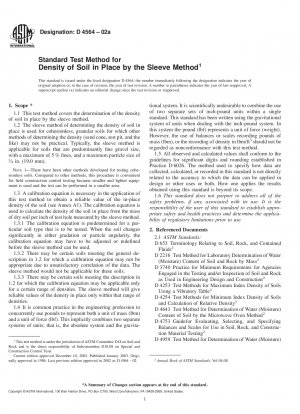ASTM D4564-02a
Standard Test Method for Density of Soil in Place by the Sleeve Method
- Standard No.
- ASTM D4564-02a
- Release Date
- 2002
- Published By
- American Society for Testing and Materials (ASTM)
- Status
- Replace By
- ASTM D4564-08
- Latest
- ASTM D4564-08e1
- Scope
This test method is used to determine the density of cohesionless soil used in the construction of earth embankments and roadfills, or of cohesionless soils used for structure backfill, bedding and backfill for pipe, or filters. This test method is used as the basis for acceptance of soils compacted to a specified density or to a specified relative density.
This test method may be useful in determining the density of cohesionless soils in a confined or limited space since this test method requires less working area than other methods.
A predetermined calibration equation is necessary to use this procedure (see Annex A1). It is assumed there is a linear relationship between the density in place and the mass of dry soil per inch of test hole measured by the sleeve method. This may not be true for certain soils or the linear relationship may exist only for a particular range of densities.
The quality of the results produced by this standard is dependent on the competence of the personnel performing it, and the suitability of the equipment and facilities used. Agencies that meet the criteria of Practice D 3740
are generally considered capable of competent and objective testing. Users of this standard are cautioned that compliance with Practice D 3740 does not in itself assure reliable results. Reliable results depend on many factors: Practice D 3740 provides a means of evaluating some of those factors. 1.1 This test method covers the determination of the density of soil in place by the sleeve method.
1.2 The sleeve method of determining the density of soil in place is used for cohesionless, granular soils for which other methods of determining the density (sand cone, test pit, and the like) may not be practical. Typically, the sleeve method is applicable for soils that are predominantly fine gravel size, with a maximum of 5 % fines, and a maximum particle size of 3/4 in. (19.0 mm).
Note 18212;There have been other methods developed for testing cohesionless soils. Compared to other methods, this procedure is convenient for field construction control testing because smaller and lighter equipment is used and the test can be performed in a smaller area.
1.3 A calibration equation is necessary in the application of this test method to obtain a reliable value of the in-place density of the soil (see Annex A1). The calibration equation is used to calculate the density of the soil in place from the mass of dry soil per inch of test hole measured by the sleeve method.
1.3.1 The calibration equation is predetermined for a particular soil type that is to be tested. When the soil changes significantly in either gradation or particle angularity, the calibration equation may have to be adjusted or redefined before the sleeve method can be used.
1.3.2 There may be certain soils meeting the general description in 1.2 for which a calibration equation may not be appropriate due to unsatisfactory correlation of the data. The sleeve method would not be applicable for these soils.
1.3.3 There may be certain soils meeting the description in for which the calibration equation may be applicable only for a certain range of densities. The sleeve method will give reliable values of the density in place only within that range of densities.
1.4 It is common practice in the engineering profession to concurrently use pounds to represent both a unit of mass (lbm) and a unit of force (lbf). This implicitly combines two separate systems of units; that is, the absolute system and the gravitational system. It is scientifically undesirable to combine the use of two separate sets of inch-pound units within a single standard. This standard has been written using the gravitational system of units when dealing with the inch-pound system. In this syste......
ASTM D4564-02a Referenced Document
- ASTM D2216 Standard Test Method for Laboratory Determination of Water (Moisture) Content of Soil and Rock by Mass
- ASTM D3740 Standard Practice for Minimum Requirements for Agencies Engaged in the Testing and/or Inspection of Soil and Rock as Used in Engineering Design and Construction
- ASTM D4253 Standard test method for maximum index density and unit weight of soil using a shaking table*, 2024-04-19 Update
- ASTM D4254 Standard Test Methods for Minimum Index Density and Unit Weight of Soils and Calculation of Relative Density*, 2024-04-19 Update
- ASTM D4643 Standard Test Method for Determination of Water Content of Soil and Rock by Microwave Oven Heating
- ASTM D4753 Standard Specification for Evaluating, Selecting, and Specifying Balances and Scales for Use in Soil, Rock, and Construction Materials Testing
- ASTM D4959 Standard Test Method for Determination of Water Content of Soil By Direct Heating
- ASTM D6026 Standard Practice for Using Significant Digits in Geotechnical Data
- ASTM D653 Standard Terminology Relating to Soil, Rock, and Contained Fluids
- ASTM E11 Standard Specification for Wire Cloth and Sieves for Testing Purposes
ASTM D4564-02a history
- 2008 ASTM D4564-08e1 Standard Test Method for Density and Unit Weight of Soil in Place by the Sleeve Method
- 2008 ASTM D4564-08 Standard Test Method for Density and Unit Weight of Soil in Place by the Sleeve Method
- 2002 ASTM D4564-02a Standard Test Method for Density of Soil in Place by the Sleeve Method
- 2002 ASTM D4564-02 Standard Test Method for Density of Soil in Place by the Sleeve Method
- 1993 ASTM D4564-93 Standard Test Method for Density of Soil in Place by the Sleeve Method
